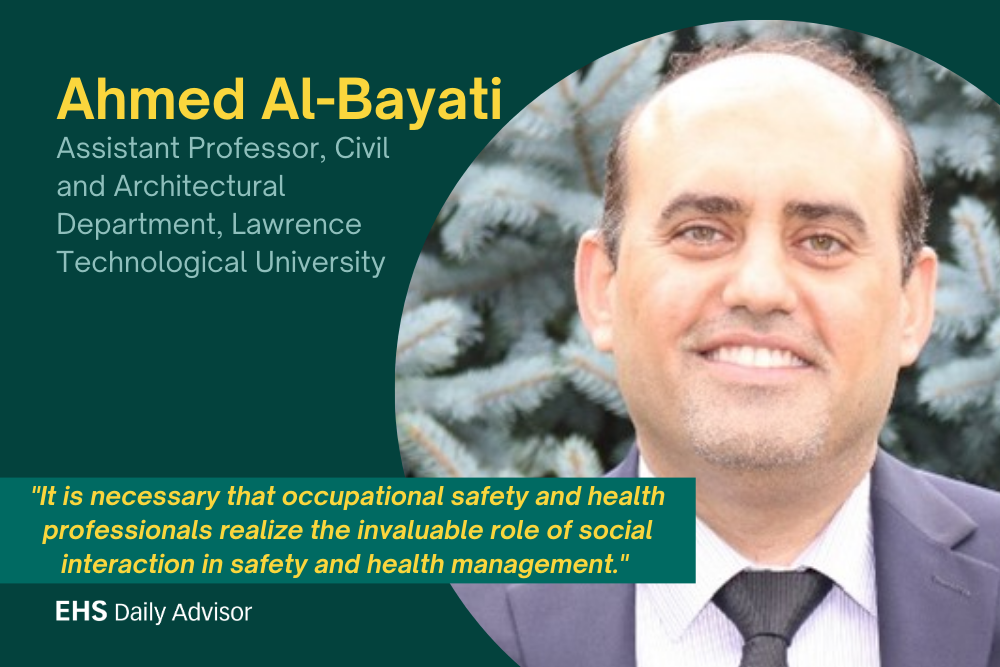Dr. Ahmed Al-Bayati is the founding director of the Construction Safety Research Center (CSRC) and an assistant professor in the Department of Civil and Architectural Engineering at Lawrence Technological University. He conducts research on construction safety, including safety culture and incident investigation, as well as underground utility management, to optimize the construction process and reduce occupational injuries and utility strikes.
He specializes in using surveys to extract information from the target population, providing a better understanding of the research topic and improving the overall process. He has authored or co-authored over 60 peer-reviewed articles and conference proceedings, and spoken at national and regional conferences across the country.
For our latest Faces of EHS profile, we sat down with Ahmed to discuss his influences in the industry, working in construction, and the possibilities of prevention through design.
Q: How did you get your start in the field?
During my formative years, I discovered a deep fascination with construction toys that soon blossomed into a passionate pursuit of civil engineering as a profession. After graduating from Babylon University in 2003 with a degree in said field, I have had the privilege to work with construction practitioners and scholars.
Q: Who has been your biggest influence in the industry?
Throughout my professional journey, every individual I have had the pleasure of collaborating with has sincerely left an indelible mark on me. If I need to refer to an individual, I must talk about Juan, a Hispanic foreman that I worked with in Dillon, SC, while I was working for Gaylor, Inc. as site safety. Juan informed me about safety management practices for Hispanic workers. Based on his insights, I suggested my PhD dissertation topic to my advisor.
Q: What’s your best mistake and what did you learn from it?
My mistakes were mostly due to my lack of experience. While my college education was valuable, I soon realized that field experience is imperative in producing high-quality work. Therefore, I strongly recommend that new graduates seek guidance and knowledge from those who possess practical experience in their field.
Q: What’s your favorite and least favorite part about working in the industry? Would you change anything?
I enjoy seeing construction projects reach completion and benefit end users. I hope the industry prioritizes safety to reduce occupational injuries, especially fatal and severe ones.
Q: What are your thoughts on safety culture? How can company leaders make safety a value within their organization?
Safety culture is a shared responsibility. Construction firm stakeholders (i.e., upper management, safety personnel, frontline supervisors, and workers) must all contribute to overall site safety performance. In one of my studies, I discovered that the actions of upper management and safety personnel significantly influence the safety-related actions of frontline supervisors and field workers.
Q: What safety concerns or issues do you think need more prioritization in EHS programs?
Prevention through Design (PtD) has a potential to significantly reduce occupational injuries. I think there is a dire need to integrate PtD into civil engineering programs. Civil engineers are well-positioned to lead PtD collaborative initiatives due to their regular interactions with owners, architects, and builders.
Q: How will new safety technologies influence the work being done by EHS professionals?
The impact of emerging technologies on occupational safety and health management is significant. However, it is necessary that occupational safety and health professionals realize the invaluable role of social interaction in safety and health management. The social aspect of occupational safety and health management is non-negotiable and is imperative for occupational safety and health professionals to consider effective occupational safety and health management.
Q: What are you most proud of?
As an immigrant who moved to the United States in 2009, I am proud of being able to transform my profession from a car driver in 2013 to a college professor 2017. Since then, I was able to author and co-author more than 60 peer-reviewed articles and conference proceedings.
Q: Do you have any advice for people entering the profession?
Entering the safety and health profession is a noble and vital career choice, as it involves safeguarding the well-being of individuals in various settings. They must equip themselves with the needed knowledge and skills. According to my recent study, the experience of safety personnel and completion of certificate programs significantly contribute to higher level of safety performance. To enhance their profession, I strongly encourage them to prioritize these two aspects.

